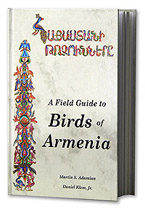- Pictures of All Birds
- Find Bird by Common Name
- Find Bird by Scientific Name
- Find Bird by Armenian Name
- Orders of Birds
- Distribution Maps
- Location of Armenia
- Species of Special Concern

Purchase the Field Guide
© Copyright Birds
of Armenia Project

| Armenian Name: | Սպիտակագլուխ անգղ |
|---|---|
| Species Status: | Undetermined Species - Species of Special Concern |

See Plate 9 for Eurasian Griffon, Griffon Vulture and other similar species
| Resident Status: | Year-round resident |
|---|---|
| Abundance: | Uncommon |
| Length: | 95-105 cm, Wing Span:240-280 cm |
| Distribution Map: | Map 33. |
| Description: | Large vulture with small head, long neck that is tucked into body in flight, broad wings with bulging secondaries and narrower outerwing; short rounded tail. |
| Adult: | Pale grayish head and neck with white collar at base. Pale brown body; pale lines on underwing coverts contrast with dark flight feathers. |
| Juvenile: | Similar to adult but darker above with paler underwing lining. |
| Similar Species: | Differs from Eurasian Black Vulture by pale body and wing coverts contrasting with dark flight feathers. |
| Behavior: | Soars on raised wings at high altitudes, often in small groups. Gathers at carcasses where individuals are highly aggressive toward one another. Dominant over Egyptian Vulture but not Eurasian Black Vulture. Needs running space to take off from flat ground. |
| Habitat: | Mountain cliffs, river gorges, forests, and arid regions. Forages over semideserts, steppe, alpine meadows, and river valleys. |
| Food: | Carrion, especially internal organs and other soft tissues. |
| Nest: | Typically colonial; pile of branches lined with twigs, grass, and rags on cliff ledge or in deep cave. |
| Eggs: | 90 mm, 1-2, white. |